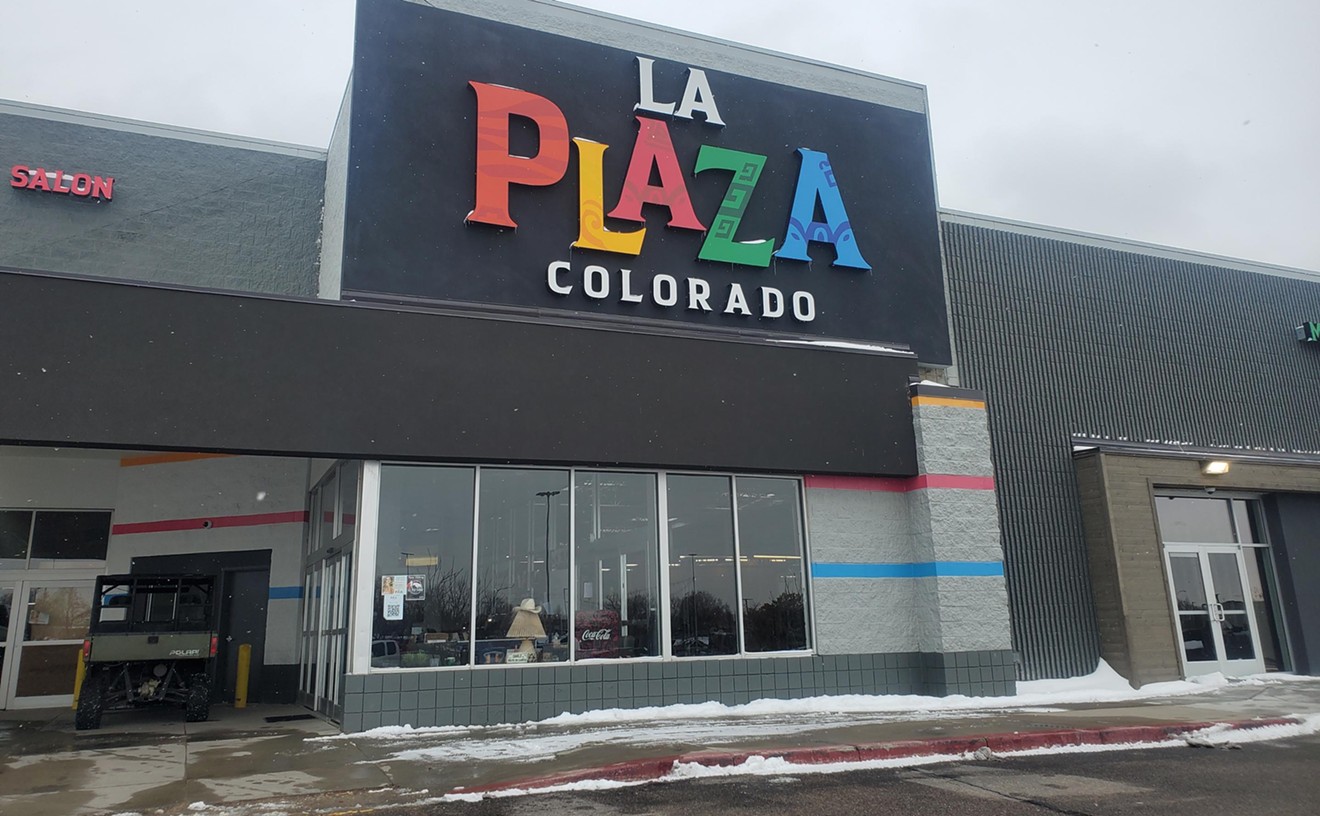A stormy night in Boulder, rain lashing down, flood warning in effect, and four of us sitting in a comfortable corner of the Dushanbe Teahouse. Looking out, we can see the swollen creek rushing by, and we speculate on just how high it might rise. There's no one on the pleasant patio where people usually gather to sip tea and listen to the sounds of moving water. Rob, Dorothy, Marykate and I are safe, dry and warm inside, though, contemplating a plate of Korean-style ribs and agreeing that the only possible way to eat them is with our fingers. They turn out to be unexpectedly succulent, complemented by a little relish. My friends order cocktails made with tea and pronounce them delicious, and then our main courses arrive and we're passing little bites around the table so that everyone can taste everything. The menu items are eclectic and international, ranging from Brazilian vatapá to Persian spice-rubbed chicken (khoresht-e). All of our dishes are excellent, but the standouts are Marykate's perfectly cooked Bengali salmon and my Catalonian pork chop with piri piri Yukon Gold potatoes. The chop is so large and thick that I know it has to be overcooked, but when I assay the thing, my knife slides through it like butter. Dabble a piece in the piri piri and it's sheer heaven. We accompany the meal with a 2007 Ramón Bilbao Rioja Crianza, and when the bottle's empty, everyone yearns for more.
The Teahouse is in many ways the heart of Boulder. It buzzes with activity from morning to night, serving breakfast, lunch, tea, dinner and all kinds of snacks in between. Farmers' market days see shoppers running in for a quick cup, or to lead a jittery child to the john (public access to the restroom is an actual requirement of the lease the operators signed with the city). You also come here for a long gossipy coffee with a friend you haven't seen in a while. You bring in out-of-town visitors, proudly pointing out the details of the decor: the intricate patterns on the hand-carved pillars, the painted tiles, the fish gliding through the pool and fountain at the building's center, the seven statues of women — figures from a twelfth-century work by Persian poet Nizami Ganjavi — ringing the water. If you're feeling a little under the weather, you drop in for a tea or tisane because Sara Martinelli, who runs the place with her husband Lenny, is a skilled herbalist and certainly has something that will help you. Besides, the waitstaff are so solicitous — in an entirely unpushy way — that their voices alone can soothe, and you half expect that if you complain of sleeplessness, your waiter will start crooning a lullabye. (Just to be clear, he won't.) We in Boulder see this as our place, the center of the community, an affirmation of who we essentially are and also a window to the wider world. But the building's genesis spoke less about intercultural communication than about Boulder's profound insularity.
You could date the beginning of this story to the teahouses of the ancient Silk Road, the network of trade routes connecting Asia, Europe and parts of Africa and a nexus of artistic, culinary and cultural exchange. Or you could date it to the 1987 visit of Dushanbe mayor Maksud Ikramov. His city had been chosen by Boulder's Sister City Program for its similarities to Boulder: Both are at the same latitude, both have universities, and both are surrounded by high, white-capped mountains. Ikramov was a thoughtful and progressive man, anxious to extend a hand of friendship to the United States, and he told Mary Hey, then head of the program, that he would like to give Boulder a traditional Tajik teahouse, or chaikhona. Gorbachev was in power in the Soviet Union at the time, and the freshening breezes of glasnost and perestroika were blowing through the region. Within months, money had been allocated by the government of Tajikistan. Red cedar wood arrived from Siberia — funded by Moscow; Tajik artisans started putting plans for the structure together. The teahouse's Boulder architect, Vern Seieroe (who would later describe the experience as one of the most compelling of his life), visited Dushanbe in 1988 with then-mayor Linda Jourgensen and Sister Cities' Mary Axe, and began a collaboration with his counterpart there, Lado Shanidze, to ensure that Shanidze's design would work in Boulder.
But when the offer was brought home, Boulder responded with a roar of outrage: How dare this upstart foreign mayor offer the town such a magnificent gift?
There were some legitimate concerns, of course. How much would it cost to bring the teahouse here and set it up? Where was it to be sited? Who would run the place, and as what: a museum piece, a functioning restaurant, an authentic Persian teahouse? A committee was formed to decide whether to accept the teahouse, and its deliberations took more than a year. Meanwhile, Klagenfurt, a similar-sized Austrian town that had been offered a smaller teahouse from Dushanbe, got theirs sited within a week and erected it, using government funds, without generating a peep of controversy. Eventually, Boulder agreed to accept Mayor Ikramov's gift, and in 1990 the teahouse arrived in boxes.
Then began seven years of furious argument among the citizenry while the cost of erecting the teahouse rose relentlessly year by year — from roughly $250,000 to $800,000. From the left came the cry that the money would be better used to help Boulder's poor; organizers of a sister-city project in Nicaragua felt it should be spent to bring potable water to Jalapa. The Cold Warriors fired away from the right: Bob Brown of Soldier of Fortune — a publication for mercenaries — told Westword: "It's a bunch of warm-fuzzy bullshit, but...this wonderful little city was home to a giant Soviet radar station.... I toyed with the idea of getting architectural plans for this thing and renovating it into a shelter for battered women...instead of a place where the fucking yuppies can drink tea." His associate editor, Tom Bates, falsely claimed that Dushanbe was a staging area for Soviet bombers departing for Afghanistan, and at a Boulder City Council meeting, a resident expressed her fear that Moscow would install listening devices in the teahouse to spy on Rocky Flats.
Boulder Action for Soviet Jewry wanted the Dushanbe Sister City organizers to cease their activities and concentrate instead on helping Jews leave Tajikistan, because the fall of the Soviet Union meant there were sure to be pogroms against Jews by Muslims.
In short, critics used whatever ammunition came to hand: The money should go toward tax relief for homeowners or to eliminate a three-dollar fee paid by bicyclists. After student riots rocked the Hill, the Boulder Weekly complained that the teahouse would be "within Molotov cocktail throwing distance of the Hill" (that thrower would have one hell of an arm!) and asked if a SWAT team would be in place for protection.
Many protests were incoherent or just plain xenophobic, a bitch list of everything that annoyed everyone about Boulder, from transients to prairie dogs. The teahouse should be fitted with "voice-activated machines that vend quarters at the sound of begging and all the muscatel you can drink" and used to lure homeless people away from the downtown area, according to a would-be humorous column in the Daily Camera. Weekly readers suggested it be used as firewood or a Fourth of July bonfire, or for target practice. A letter to the editor from the What Price Tea Committee suggested that the price of a cup of tea would have to include all the costs of "keeping all its cute little painty pieces painted as well as all the little un-painty pieces unpainted and a sizeable slush fund for attorneys' fees when Mrs. Got-Rocks spills her hot tea in her lap."
Seldom has a gift been received with so little grace.
Once the current 13th Street site was selected, there was a chorus of concern that it was in the floodplain. And when contamination was eventually discovered on the site, the funding sources that the organizers had managed to muster simply vanished.
Through it all, the teahouse sat in Boulder's sewage-treatment plant in a dozen twenty-foot containers, protected by a couple of skilled feline mousers.
Axe, Seieroe and other supporters worked tirelessly, but they were at their wits' end by the time they met with then-city manager Tim Honey. Says Seieroe: "We'd put thousands of hours into this, but we told him we couldn't go on. 'What do we do now?' we asked. 'Send it back? Sell it?'" Honey was sympathetic, and despite continued and vociferous opposition from some city council members — particularly then-deputy mayor Spence Havlick and Lisa Morzel, who has been re-elected and is currently Boulder's deputy mayor — he and Linda Jourgensen figured out a funding mechanism.
A grant from the National Endowment for the Arts brought four craftspeople from Tajikistan to help set up the teahouse. When the pieces were liberated from their cartons, Seieroe was delighted to find them almost completely undamaged and Shanidze's measurements accurate to a fraction of an inch. The visiting craftsmen gave workshops; a local Iranian carpenter provided work and translation services, along with pilaf and a samovar of tea when the visitors broke Ramadan; passersby stopped as the work was going on to examine the tiles and panels. And by the time the teahouse opened for business in 1998, the carping had melted away like a late-spring snow, and the building was described in all the local papers as a "jewel."
Seieroe smiles ruefully. "I spent years trying to explain what this gift was, how beautiful it was," he says. "I described it as Persian with an Islamic overcoat, a melding of cultures and of traditional and modern. I never succeeded — until people saw it."
But the headaches were just beginning for the Martinellis, who had submitted the winning proposal for running the teahouse for the city. They were the founders of the Naropa Cafe; Sara had just finished a degree in graphic design; they had two children and a new baby. That first year, she says, "it felt like we were on a runaway horse and holding on for dear life."
Work was still going on inside the teahouse as the Martinellis prepared for opening day — which happened to fall on both graduation and Mother's Day weekend — and they were forced to train their staff in the parking lot. The farmers' market was in full swing on the street outside that morning, dignitaries were on hand, and a line of potential customers snaked down the block. "I kept telling myself, if we get through this weekend, we're going to make it," Sara remembers. They did make it, though there were a few glitches, and she still cringes at the memory of an almost-raw piece of salmon served to a patron.
With the teahouse menu, the Martinellis decided to honor the Sister City concept with traditional ethnic cuisines. But it was hard to find chefs because of the strong focus on French cuisine in most culinary schools. "We wanted not just any old Indian curry," Lenny says, "but specifically food from, say, the Punjab. We were making chimichurri here years ago. I found the recipe in a beat-up Argentinian cookbook. Now it's everywhere, but no one had heard of it then."
Affordability was a primary motive when the couple started Three Leaf Farm a year ago to provide produce, eggs and honey for the teahouse and the four other restaurants they now own: Aji, Leaf, Zucca and Huckleberry. All waste from every restaurant is composted; Lenny is obsessed with compost, and can wax lyrical about eggshells. The Martinellis' dedication to local sourcing and sustainability led to their recently being named Nature's Plate People's Choice Winner for the metro area in a contest run by the Nature Conservancy and OpenTable. With a farm, Sara says, "you're so much more invested in every step of the production. Our son probably harvested the vegetables you and your friends ate."
The empathetic waitstaff is no accident, either. "They have to deal with over 100 hand-processed teas from all major growing regions, and wine from all over the world," says Lenny. "We want to take people on a journey, and the guide is your server."
Unfortunately, both Mayor Maksud Ikramov and architect Lado Shanidze died before the Dushanbe Teahouse was ever unpacked, but their gift is now a reliable source of revenue for the City of Boulder. And if the process of erecting it revealed the ugliest side of the town, dozens of people have assisted in the coming together of what is now a community institution. Start with the patient work of Mary Axe and the Sister City organizers, and the vision of Honey (who resigned under pressure soon after his decisive decision to support the teahouse). Move to the third and fourth-generation Tajik craftsmen who came here to teach and to learn, and the local artists who worked with them. Add Harlequin Gardens, which maintains the fragrant rose garden in front. And consider the eclecticism, idealism and business acumen of the Martinellis, who somehow managed to bring all the diverse strands into harmony.
It's dark outside the window, and the rain has eased. We're relieved that the stifling heat wave of the last few weeks has lifted, and we're talking about Ogden Nash's wonderful poems, both silly and serious. Then for some idiotic reason we start comparing our winking ability. Rob — as he reminds me firmly later — is by far the best winker in the group. Dorothy and Marykate, both young scientists, discuss the push-pull between ambition and family. We look around at the artwork, and I point out what Seieroe had pointed out to me: the peacocks at the top of two of the carved pillars. The female is looking down, and there's a tiny chick between her feet. It would take a long time, we agree, to plumb this place's riches.
"You come and sit, and it's like a flower that opens up," Seieroe had told me, quoting one of the wood carvers. "You see more every time you take it in."











